Gene editing, the direct genetic modification of cells, is already a reality regardless of whether or not you think of it as “natural” or permissible. As a holistic coach, how you handle this topic with your clients, as well as your own family, will depend greatly upon your understanding of genetics.
Did you know that gene editing is already being performed in the following ways?
- To treat inherited blindness (2018/2020)
- To make antibiotic-resistant bacteria no longer resistant (discussed as “potential” in 2022)
- To soon alter some Asian elephants into woolly mammoths, led by Harvard researchers, possibly by 2027.
- To obsolete the current practice of killing male chickens who happen to be hatched male and therefore cannot participate in the egg-laying industry that they were born into.
- To eliminate malaria-carrying mosquitoes, by making them infertile and giving them mouthparts that cannot draw blood. (This was successfully performed in a London lab in 2018, with expectations to ultimately be applied to populations in the wild.)
- To alter a growth-hormone regulating gene in one kind of salmon, in order to increase the speed at which the fish grows (in effect since 1989).
- To clone high-producing cattle, swine, sheep, and goats for agricultural production (since 1996).
- To alter two IVF twin embryos with the intention of “alter[ing] the girls’ DNA so that they would be resistant to infection by HIV” (which was carried by the father). The girls were born in October 2018 in China. The lead researcher said shortly after their birth, “When Lulu and Nana were just a single cell, this surgery removed the doorway through which HIV enters to infect people. A few days later, before returning Lulu and Nana to Grace’s womb, we check[ed] how the gene surgery went by whole genome sequencing. The results indicated the surgery worked safely, as intended.” The lead scientist was jailed after a worldwide backlash.
Whatever your opinion on whether or not these things should be happening, a scientific opinion published in Nature in 2020 wrote, “The belief that legal regulation will prohibit the editing of human genes seems illusory.” In other words, gene editing is fast becoming the world we live in, whether or not you want it that way.
It is critical that people educate themselves about genetic editing now.
Questions that society will have to clarify include:
- Should laws allow scientists to manipulate genes only for those kids and adults who already have an existing disease, or do we also allow it as a form of immunity/prevention for not-yet-born kids who are somewhat likely to inherit the disease from their parents?
- Should laws allow parents to edit the genes of their children only after birth, or should editing be permitted during pregnancy, or perhaps only in the preconception phase, before the sex cells (sperm & ovum) have joined?
- And if laws allow editing during pregnancy, should it be allowed for the fetus (after about week 10), or for the embryo (weeks 3-10) or only for the fertilized egg (zygote) while it is still floating around before implantation?!
In order to be able to speak intelligently with your clients, and also to make decisions for yourself that are founded in knowledge rather than assumption, it’s important to understand a bit about how gene editing technology works, what CRISPR is, and to understand a bit more about the world inside your cells…
GENETICS OVERVIEW
You have trillions of CELLS, possibly about 37.2 trillion.
DNA exists in nearly every cell in the body (except for some like red blood cells, which do not contain a nucleus). The majority of your DNA resides in the nucleus of each cell, although some DNA lives in mitochondria.
The DNA molecule is made of chains of NUCLEOTIDES, which are made of a sugar molecule, plus a phosphate group, plus “one of four nitrogenous bases: two purines (adenine and guanine) and two pyrimidines (cytosine and thymine).”
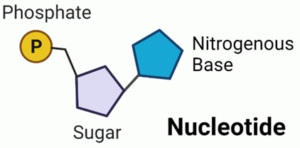
So, DNA is made up of nucleotides that are made up of three things: a sugar molecule + a phosphate group + a NUCLEOBASE , or nitrogen BASE PAIRS (A, C, G, T).

Image: What DNA actually looks like, under an electron microscope.
By some estimates, there are well more than 10 billion miles of DNA in a human being; with each cell having about 6 feet of DNA, just that it’s all balled up. There may be about 3 Billion DNA base pairs that make up the human genome. Although these numbers can give you some rough ideas about the scope of the magnitude within the tiny world of genetics, figures like these will continue to be adjusted or disproven as new scientific evidence (and appropriate counting) emerges.
DNA, along with its base pairs is commonly depicted like this:
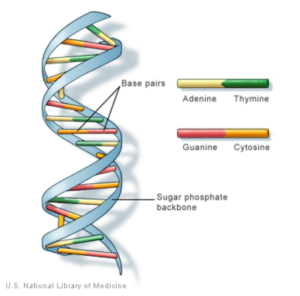
The National Human Genome Research Institute currently posits that humans are actually 99.9% identical in their genetic makeup, which means that only about 0.1% of your BASES (A, C, G, T order & configurations) differ from any random person on the street!
We humans really ARE so alike!
A GENE can be thought of as a segment of DNA,, and one that “codes for the cell’s synthesis of a specific protein.” “The key difference between DNA and genes is that DNA is a chemical structure which stores the genetic instructions and genes are small DNA stretches which determine a specific trait.” In humans, genes vary in size from a few hundred DNA bases to more than 2 million bases.
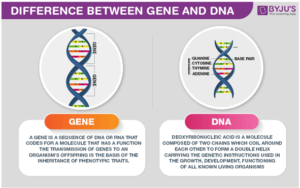
So genes can be thought of as “sections of DNA that contain the set of instructions to produce one specific molecule in your body, usually a protein. These proteins control how our body grows and works,” including characteristics such as eye color, blood type, and height.
All of the DNA of an organism is called its GENOME, which is also described as a complete set of instructions for building an entire organism. Every person’s genome has the same genes arranged in the same order, but small differences in the sequence of the bases in our genes make each person unique.
Remember that 0.1% difference in nucleotide bases? One description suggests, “One person might have the first sequence below and someone else the second. (Of course, the real sequences would be thousands of bases long, in some cases millions.)” Notice the subtle difference at just one point in the sequence…
ACCGCTTAAGCCTAGAAGCTTA
ACCGCTTAAGCCTACAAGCTTA
The study of the genome is called GENOMICS. The Human Genome Project (HGP) mapped 85% of the human genome between 1990 and 2003, with the first “gapless” (more complete) version published on March 31, 2022. When the project started, scientists thought they would be finding about 100,000 genes, but this number kept falling until now it is thought that there are about 20,000-25,000 genes in your body,, with one 2016 figure specifically chiming in at “20,687 protein-coding genes.
Two things to remember at this juncture. First, the numbers reported in this article will certainly change as research continues exploding. As of the time of this writing, these numbers should be thought of as general ideas that have a good chance of being found to be wrong in the years to come. Second, we still know very very little about our genome. For example, in 2022, the director of the National Human Genome Research Institute wrote, “It is still quite puzzling why there does not appear to be a consistent correlation between biological complexity and genome size. For example, the human genome contains about 3 billion nucleotides. While 3 billion is a big number, the rare Japanese flower called Paris japonica has a genome size of roughly 150 billion nucleotides, making it 50 times the size of the human genome.”
Nearly every cell in your body contains the set of genes that were passed from your mom and from your dad, like two sets of instructions from which to choose, just “to be sure.”
“For ease of storage and access, the genes are packaged up into 46 parcels called CHROMOSOMES.” Note the following important differences between genes and chromosomes:
- A single gene is a section of the DNA that has been wrapped into the chromosome; so a single chromosome comprises many genes.
- While gene mutations are considered relatively small, chromosomal mutations are considered relatively large.
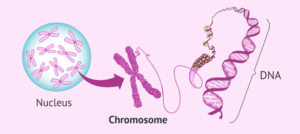
Basically, a chromosome is a molecule of tightly coiled DNA packaged together with a histone protein that helps the DNA to fit inside the nucleus of cells. Almost every cell in the human body has 46 chromosomes, or 23 sets, having inherited one set from each parent. These cells can be called diploid cells, whereas reproductive cells, which have only one-half, or 23 total chromosomes, are called haploid.
So, Chromosomes carry DNA. Sperm & ova each carry 23 chromosomes.
“Unless you are an identical twin – the egg and sperm that created you contained different combinations of your parents’ DNA than the egg and sperm that created your brother or sister,” explains the Genomics Education Programme in the UK. Because of how haploid sex cells (sperm and ova) are formed via meiosis (rather than mitosis), “46 chromosomes divide to produce four cells, each containing 23 chromosomes. During meiosis, the chromosomes are duplicated, shuffled, and separated, which ensures that each gamete produced is unique.”
So, your genetic code has two sets (one from each parent) from which you get to use to create your proteins, perhaps an evolutionary safety measure. However, because there are two copies of each gene, it also has made it more challenging for scientists to find the genetic defects and to edit the mutations. As the following images from the Hebrew University of Jerusalem depict, “detecting the biological effects of a single copy mutation is difficult because the other copy is normal and serves as a backup.”


How does RNA fit into all of this?
Genes are actually composed of stretches of DNA or RNA., While RNA is most often single-stranded compared to DNA’s double strands, both RNA and DNA each have a potential set of four bases, only that one of the bases in DNA (thymine) is swapped with uracil in RNA.

Image: RNA is single-stranded, compared to DNA’s double helix configuration.
There are several kinds of RNA :
- mRNA is the “messenger” that carries genetic data from DNA to ribosomes, which is another structure found within cells that is involved in making proteins.
- tRNA is the “transfer” molecule that brings amino acids specified by the mRNA to the ribosomes.
- rRNA is the actual “ribosomal” molecule that makes up most of the ribosome, linking amino acids together.
So, RNA & DNA are both nucleic acids, made up of the subunits called nucleotides (remember those? sugar + phosphate + bases). Note, health professionals, that a 2020 article in Live Science describes four classes of “macromolecules” (not just three) considered crucial for life: nucleic acids + proteins + lipids + carbohydrates.
RNA & DNA work together to create proteins. Remember that the big picture is that these proteins can be used to build muscles, repair organs, strengthen connective tissues, maintain pH balance, transport nutrients, carry oxygen, provide communication signals, and also to make hormones, enzymes, antibodies, and so much more! “The process of creating proteins using the genetic information in nucleic acids is so important to life that biologists call it ‘the central dogma’ of molecular biology.”
Central Dogma: DNA’s information gets transcribed into RNA information, and RNA’s information gets translated into protein., In general, this flow of information (DNA to RNA to protein) goes in one direction only, but some exceptions have been discovered, like that of infectious proteins called prions which are able to “replicate without going through DNA or RNA intermediates.”
GENE EXPRESSION
Gene expression is when a gene produces its protein, essentially the end-product that makes that cell do what it does. Gene regulation is the “process of controlling the rate and manner of gene expression.” Every cell does this except for mature red blood cells and platelets which do not contain a nucleus. Although every cell contains the full set of genes, only a fraction of them are turned on in any particular type of cell. The rest of the genes remain off. “Cells look and act the way they do because of the specific genes that they express and the amounts of gene products produced. For example, a muscle cell, a skin cell, and a nerve cell could be distinguished by their gene expression profiles.”

Image: Muscle cells, skin cells, and nerve cells are unique cells not because they have different genes, but because they consistently express certain gene combinations.
“Gene expression also varies within a certain type of cell at different points in time. For example, prostate cells might express different genes at varying quantities in normal, precancerous, and malignant states:”
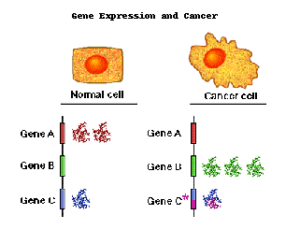
Image: The difference between a healthy cell and an unhealthy/diseased cell is that the diseased cell has decided to express a different set of genes, one that is inappropriate for this cell type and function.
Genetic Mutations
A genetic mutation is when a gene doesn’t copy correctly during cell division, affecting the expression of the gene or function of the cell. Sometimes the genetic mutations are inherited from parents, but sometimes genes mutate in your body “randomly.” Healthy genes will replicate the identical molecular structure of the DNA, as if you were to sit down and copy an instruction manual, typing it word for word. But what if a word is missed, or an extra letter or punctuation added where it’s not supposed to be? This kind of genetic mutation may function basically the same as it’s supposed to, but it might not. What if, for example, the mutation now tells the cell to replicate without regard for the surrounding tissues? (This is called cancer.)
Gene therapy is different from Gene editing. “The original gene therapy was sort of gene replacement or gene augmentation, where you’re increasing things that have gotten lower.” This often works “by adding new copies of a gene that is broken, or by replacing a defective or missing gene in a patient’s cells with a healthy version of that gene.” As an example, many of us have a basic understanding of stem cells, “master cells” that can develop into potentially any other cell in the body. “Stem cells are of great benefit to cell-based gene therapy because they are self-renewing and thus might reduce or eliminate the necessity for repeated administrations of the therapeutic cells. The overall goal of gene therapy is to cure diseases caused by malfunctioning genes.”
In an interview, the leader of Harvard’s genetics department, and really the world’s renowned authority on genetics, George Church responds to Mark Hyman’s question, “Can we imagine a gene therapy to help us recover our memory or to repair our joints or to improve our hearing…?” Church discussed how we will potentially be able to grow a limb/organ in a lab and transplant it; how since birds do not lose their hair (feathers) so we should eventually be able to turn those stem cells on, ultimately saying, “If you convince a certain subset of cells that are embryo-like or fetus-like, then they will go in and do the job that they did once before. They can do it again.”
Gene Editing
A completely different genetic technology directly edits, rather than just replacing or augmenting. “Genome editing can be used to correct, introduce or delete almost any DNA sequence in many different types of cells and organisms.” Yes, you read that correctly. “Editing is typically either removing a gene function or changing it precisely, and it’s usually thought of in terms of inherited diseases…you go in and change one base pair back to what it should be (what it is in the healthy population).”
Essentially, that A-C-G-T sequence can be directly edited, which directly affects how the cells do their job.
“Genome editing (also called gene editing) is a group of technologies that give scientists the ability to change an organism’s DNA. These technologies allow genetic material to be added, removed, or altered at particular locations in the genome. Several approaches to genome editing have been developed. A well-known one is called CRISPR-Cas9, which is short for clustered regularly interspaced short palindromic repeats and CRISPR-associated protein 9.”
CRISPR
CRISPR, the technology that makes it possible for scientists to “target and modify ‘typos’ in the three-billion-letter sequence of the human genome” (literally down to a single base letter now with the new Cas9 enzyme) is actually a naturally occurring phenomenon. It’s not a machine that was invented by scientists, but rather a sequence of DNA that was discovered in bacteria.
“The term “CRISPR”…describes a region of DNA made up of short, repeated sequences with so-called ‘spacers’ sandwiched between each repeat… In a CRISPR region, these bases appear in the same order several times, and in these repeated segments, they form what’s known as ‘palindromic’ sequences…A palindrome, like the word ‘racecar,’ reads the same forward as it does backward; similarly, in a palindromic sequence, bases on one side of the DNA ladder match those on the opposing side when you read them in opposite directions…Short palindromic repeats appear throughout CRISPR regions of DNA.”
Racecar spelled backward is racecar. This is a palindrome sequence.
These sequences were first discovered in bacteria, where it was proposed that these CRISPR regions served as part of the bacterial immune system.
“Researchers adapted this immune defense system to edit DNA. They create a small piece of RNA with a short ‘guide’ sequence that attaches (binds) to a specific target sequence in a cell’s DNA, much like the RNA segments bacteria produce from the CRISPR array. This guide RNA also attaches to the Cas9 enzyme. When introduced into cells, the guide RNA recognizes the intended DNA sequence, and the Cas9 enzyme cuts the DNA at the targeted location, mirroring the process in bacteria. Although Cas9 is the enzyme that is used most often, other enzymes (for example Cpf1) can also be used. Once the DNA is cut, researchers use the cell’s own DNA repair machinery to add or delete pieces of genetic material, or to make changes to the DNA by replacing an existing segment with a customized DNA sequence.”
So, CRISPR sequences, called “CRISPR RNAs” or “crRNAs” (from the bacteria), are able to find matching palindrome sequences of DNA inside the human body, with the help of other guide RNA (gRNA) sequences telling the CRISPR where to go. Then the Cas9 enzyme either cuts the DNA or activates the gene expression. Plasma or viral vector infusions made up of bacterial crRNA, Cas9, gRNA (either genes or synthetic) are injected into patients in a variety of formats called either “protein delivery” or “gene delivery” or “RNA delivery.” An experimental therapy reported in Science in 2021 gives a sense for how CRISPR can be administered, “The treatment required removing a patient’s diseased blood stem cells, modifying them with CRISPR in a dish, and then infusing them back into the body. A trial testing a direct injection of a virus encoding CRISPR’s components into the eye to treat a condition that causes blindness is also underway.”
This technology continues to be the most exciting thing within practically the entire scientific community, but it is so radically beyond what humanity has known that, as the technology continues to get more and more precise, and more and more useful with disease and agriculture and more, it may be only a matter of time before it is used cosmetically, as in the case of “designer babies.” A designer baby is has been identified as one whose genetic makeup can be selected (ie. which fertilized egg do you want, blue eyes or brown eyes, boy or girl?) but may instead turn into one whose genetic makeup may soon be directly edited.
What does this mean for the holistic coach?
Well, the world is changing fast, and you need to be ready for that change. Greek philosopher, Heraclitus, is referenced to have said that “Change is the only constant in life.” Will you find yourself amongst the group who is praying for the world not to change or will you instead pray for yourself to be able to handle that change?
Your kids may very well decide to genetically edit their own kids, your grandchildren. In fact, you might still be in your childbearing years when this option becomes available for yourself, for your own kids. This technology is already being used to cure blindness, augment medications, enhance animal and agricultural production, potentially alter the course of which animals go into (or return from) extinction, and has already pushed the boundaries on the world stage.
Stem cell research has been fought in certain states and countries, only to create thriving businesses in other countries. Is it reasonable to expect that the world will not keep moving forward here consistently?
My hope with this article is to help provide an understanding of the science behind this inevitable shift so that you can simply be aware – for yourself and for your clients – of how to navigate the future.
For discussion on topics such as genetics, epigenetics, and more, check out our Holistic Fertility & Pregnancy Safe Membership Program which goes beyond traditional pre & postnatal education.
REFERENCES
- First CRISPR therapy dosed. Nature Biotechnology. Retrieved 10/11/22 from https://doi.org/10.1038/s41587-020-0493-4
- Tao, et al. The Application of the CRISPR-Cas System in Antibiotic Resistance. Infection and Drug Resistance. Retrieved 10/11/22 from https://doi.org/10.2147/IDR.S370869
- Shankland, Stephen. Woolly mammoths could walk the Earth again by 2027 if CRISPR startup succeeds. CNET. Retrieved 10/11/22 from https://www.cnet.com/science/woolly-mammoths-could-walk-the-earth-again-by-2027-if-crispr-startup-succeeds/
- Ryan, Jackson. How CRISPR could save 6 billion chickens from the meat grinder. CNET. Retrieved 10/11/22 from https://www.cnet.com/science/how-crispr-could-save-6-billion-chickens-from-the-meat-grinder/
- Ryan, Jackson. The CRISPR machines that can wipe out entire species. CNET. Retrieved 10/11/22 from https://www.cnet.com/science/the-crispr-machines-that-can-wipe-out-entire-species/
- Dunning, Hayley. Mosquitos that can carry malaria eliminated in lab experiments. Imperial College London. Retrieved 10/11/22 from https://www.imperial.ac.uk/news/188291/mosquitoes-that-carry-malaria-eliminated-experiments
(n.d.) AquaAdvantage Salmon. WIkipedia. Retrieved 10/11/22 from https://en.wikipedia.org/wiki/AquAdvantage_salmon
(n.d) A primer on cloning and its use in livestock operations. Animal Cloning. FDA. Retrieved 10/11/22 from https://www.fda.gov/animal-veterinary/animal-cloning/primer-cloning-and-its-use-livestock-operations
- Regalado, Antonio. THe creator of the CRISPR babies has been released from a Chinese Prison. MIT Technology Review. Retrieved 10/11/22 from https://www.technologyreview.com/2022/04/04/1048829/he-jiankui-prison-free-crispr-babies/
- YouTube: The He Lab. About LUlu and Nana: Twin Girls Born Healthy After Gene Surgery As Single-Cell Embryos. https://www.youtube.com/watch?v=th0vnOmFltc
- Krekora-Zajac, Dorota. Civil liability for damages related to germline and embryo editing against the legal admissibility of gene editing. Palgrave Communications. Retrieved 10/11/22 from https://www.nature.com/articles/s41599-020-0399-2
- Zimmer, Carl. How many cells are in your body? National Geographic. Retrieved 10/11/22 from https://www.nationalgeographic.com/science/article/how-many-cells-are-in-your-body
https://my.clevelandclinic.org/health/body/23064-dna-genes–chromosomes
https://www.britannica.com/science/DNA
Image: 2022. Kulkarni, Nidhi Abhay. Nucleotide- definition, characteristics, biosynthesis, functions. Microbe notes. Retrieved 10/11/22 from https://microbenotes.com/nucleotide/
https://www.livescience.com/what-is-RNA.html
https://medlineplus.gov/genetics/understanding/basics/dna/
Image: 2012. Garber, Megan. What DNA Actually Looks Like. The Atlantic. Retrieved 10/11/22 from https://www.theatlantic.com/technology/archive/2012/11/what-dna-actually-looks-like/265713/
- Starr, Barry. A Long and Winding DNA. KQED. Retrieved 10/11/22 from https://www.kqed.org/quest/1219/a-long-and-winding-dna
- The 99 percent…of the human genome. SITN. Harvard. Retrieved 10/11/22 from https://sitn.hms.harvard.edu/flash/2012/issue127a/
Image: (n.d.) What is DNA? MedlinePlus. Retrieved 10/11/22 from https://medlineplus.gov/genetics/understanding/basics/dna
(n.d.) Genetics vs Genomics Fact Sheet. National Human Genome Research Institute. Retrieved 10/12/22 from https://www.genome.gov/about-genomics/fact-sheets/Genetics-vs-Genomics
https://medlineplus.gov/genetics/understanding/basics/dna/
https://www.britannica.com/science/DNA
- Finegold, David, MD. Genes and Chromosomes. Merck Manual. Retrieved 10/11/222 from https://www.merckmanuals.com/home/fundamentals/genetics/genes-and-chromosomes
https://www.britannica.com/science/DNA
https://medlineplus.gov/genetics/understanding/basics/gene/
Image: Difference between Gene and DNA. BYJU’s. Retrieved 10/11/22 from https://byjus.com/biology/difference-between-gene-and-dna/ https://byjus.com/biology/difference-between-gene-and-dna/
https://www.genome.gov/genetics-glossary/Genome
(n.d.) What are DNA and Genes? Learn. Genetics. Genetic Science Learning Center. University of Utah. Retrieved 10/11/22 from https://learn.genetics.utah.edu/content/basics/dna
(n.d. – near 2018) Sladin, Ken. Quora. Retrieved 10/12/22 from https://www.quora.com/What-is-the-main-thing-which-is-different-in-DNA-about-99-of-DNA-is-same-in-all-humans-what-is-that-1-matter
https://en.wikipedia.org/wiki/Human_Genome_Project
https://my.clevelandclinic.org/health/body/23064-dna-genes–chromosomes
https://medlineplus.gov/genetics/understanding/basics/gene/
- DNA, Genes, Chromosomes. Genetic Alliance UK. Retrieved 10/11/22 from https://geneticalliance.org.uk/information/learn-about-genetics/dna-genes-chromosomes-and-mutations/
- Green, Eric, MD, PhD. Genome. National Human Genome Research Institute. NIH. Retrieved 10/12/22 from https://www.genome.gov/genetics-glossary/Genome
website: https://geneticalliance.org.uk/information/learn-about-genetics/dna-genes-chromosomes-and-mutations/
website: https://byjus.com/biology/difference-between-gene-and-chromosome/
Image: What are Chromosomes? inviTRA. Retrieved 10/11/22 from https://www.invitra.com/en/chromosome/
website: https://my.clevelandclinic.org/health/body/23064-dna-genes–chromosomes
website: https://geneticalliance.org.uk/information/learn-about-genetics/dna-genes-chromosomes-and-mutations/
(n.d.) Where does our genome come from? Genomics Education Programme. Health Education England NHS. Retrieved 10/11/22 from https://www.genomicseducation.hee.nhs.uk/education/core-concepts/where-does-our-genome-come-from/
(n.d.) Where does our genome come from? Genomics Education Programme. Health Education England NHS. Retrieved 10/11/22 from https://www.genomicseducation.hee.nhs.uk/education/core-concepts/where-does-our-genome-come-from/
(n.d.) The Hebrew University of Jerusalem. (2:09-2:19) Retrieved 10/11/22 from http://wapo.st/1S4vxva
Images: (n.d.) The Hebrew University of Jerusalem. (2:09-2:19) Retrieved 10/11/22 from http://wapo.st/1S4vxva
website: https://pediaa.com/difference-between-dna-and-genes/
website: https://byjus.com/biology/difference-between-gene-and-dna/
website: https://www.genome.gov/genetics-glossary/RNA-Ribonucleic-Acid
website: https://www.newscientist.com/definition/rna/
- Dhar, Michael. What is RNA? LiveScience. Retrieved 10/11/22 from https://www.livescience.com/what-is-RNA.html
- Dhar, Michael. What is RNA? LiveScience. Retrieved 10/11/22 from https://www.livescience.com/what-is-RNA.html
- Dhar, Michael. What is RNA? LiveScience. Retrieved 10/11/22 from https://www.livescience.com/what-is-RNA.html
- Dhar, Michael. What is RNA? LiveScience. Retrieved 10/11/22 from https://www.livescience.com/what-is-RNA.html
website: https://atdbio.com/nucleic-acids-book/Transcription-Translation-and-Replication
- Ostrander, Elaine, PhD. Central Dogma. National Human Genome Research Institute. Retrieved 10/11/22 from https://www.genome.gov/genetics-glossary/Central-Dogma
- Lakna. What is the difference between gene expression and gene regulation. PEDIAA. Retrieved 10/12/22 from https://pediaa.com/what-is-the-difference-between-gene-expression-and-gene-regulation
(n.d.) Can genes be turned on and off in cells? MedlinePlus. Retrieved 10/11/22 from https://medlineplus.gov/genetics/understanding/howgeneswork/geneonoff/
- Greer, Renata. Gene Expression. NCBI Genetics Review. Retrieved 10/11/22 from https://www.ncbi.nlm.nih.gov/Class/MLACourse/Original8Hour/Genetics/gene_expression.html
Image: 2001. Greer, Renata. Gene Expression. NCBI Genetics Review. Retrieved 10/11/22 from https://www.ncbi.nlm.nih.gov/Class/MLACourse/Original8Hour/Genetics/gene_expression.html
- Greer, Renata. Gene Expression. NCBI Genetics Review. Retrieved 10/11/22 from https://www.ncbi.nlm.nih.gov/Class/MLACourse/Original8Hour/Genetics/gene_expression.html
Image: 2001. Greer, Renata. Gene Expression. NCBI Genetics Review. Retrieved 10/11/22 from https://www.ncbi.nlm.nih.gov/Class/MLACourse/Original8Hour/Genetics/gene_expression.html
website: https://my.clevelandclinic.org/health/body/23064-dna-genes–chromosomes
website: https://fcit.usf.edu/matrix/project/cartoon-woman-using-typewriter/
2022, August 31. YouTube: Mark Hyman, MD. The SHOCKING Science on Extending & Reversing LIFESPAN | George Church. (21:30-21:42). Retrieved 10/12/22 from https://www.youtube.com/watch?v=nitieTtb4Lw
website: https://www.genome.gov/genetics-glossary/Gene-Therapy
- Rafi, Mohammad. Gene and Stem Cell Therapy: Alone or in Combination? Bioimpacts. Retrieved 10/11/22 from https://www.ncbi.nlm.nih.gov/pmc/articles/PMC3648974
2022, August 31. YouTube: Mark Hyman, MD. The SHOCKING Science on Extending & Reversing LIFESPAN | George Church. (24:45- 26:28). Retrieved 10/12/22 from https://www.youtube.com/watch?v=nitieTtb4Lw
website: https://www.nih.gov/news-events/gene-editing-digital-press-kit
2022, August 31. YouTube: Mark Hyman, MD. The SHOCKING Science on Extending & Reversing LIFESPAN | George Church. (21:40-22:05). Retrieved 10/12/22 from https://www.youtube.com/watch?v=nitieTtb4Lw
website: https://medlineplus.gov/genetics/understanding/genomicresearch/genomeediting/
(n.d.) Questions and answers about CRISPR. Broad Institute. Retrieved 10/11/22 from https://www.broadinstitute.org/what-broad/areas-focus/project-spotlight/questions-and-answers-about-crispr
- Ledford, Heidi. Super-precise CRISPR tool enhanced by enzyme engineering. Nature. Retrieved 10/11/22 from https://www.nature.com/articles/d41586-020-00340-w
- Vidyasagar, Aparna. Lanese, Nicoletta. What is CRISPR? Live Science. Retrieved 10/11/22 from https://www.livescience.com/58790-crispr-explained.html
website: https://medlineplus.gov/genetics/understanding/genomicresearch/genomeediting/
(n.d.) Questions and Answers About CRISPR. Broad Institute. Retrieved 11/14/22 from https://www.broadinstitute.org/what-broad/areas-focus/project-spotlight/questions-and-answers-about-crispr
(n.d.) Questions and Answers About CRISPR. Broad Institute. Retrieved 11/14/22 from https://www.broadinstitute.org/what-broad/areas-focus/project-spotlight/questions-and-answers-about-crispr
- Mout, et al. In Vivo Delivery of CRISPR/Cas9 for Therapeutic Gene Editing: Progress and Challenges. Bioconjugate Chemistry. Retrieved 11/14/22 from https://www.ncbi.nlm.nih.gov/pmc/articles/PMC5846329/
- Kaiser, Jocelyn. CRISPR injected into the blood treats a genetic disease for first time. Science. Retrieved 11/14/22 from https://www.science.org/content/article/crispr-injected-blood-treats-genetic-disease-first-time
(n.d.) Designer Baby. Wikipedia. Retrieved 10/11/22 from https://en.wikipedia.org/wiki/Designer_baby
